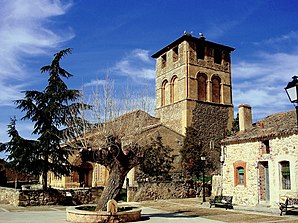Sotosalbos
| Sotosalbos municipality | ||
|---|---|---|
 Sotosalbos - the village with the church of San Miguel
|
||
| coat of arms | Map of Spain | |
 Help on coat of arms |
|
|
| Basic data | ||
| Autonomous Community : |
|
|
| Province : | Segovia | |
| Comarca : | Tierras de Segovia | |
| Coordinates | 41 ° 2 ′ N , 3 ° 56 ′ W | |
| Height : | 1170 msnm | |
| Area : | 23.92 km² | |
| Residents : | 120 (Jan. 1, 2019) | |
| Population density : | 5.02 inhabitants / km² | |
| Postal code : | 40170 | |
| Municipality number ( INE ): | 40199 | |
| administration | ||
| Website : | Sotosalbos | |
Sotosalbos is a small mountain village in central Spain with only 120 inhabitants (as of January 1, 2019) in the province of Segovia in the autonomous community of Castile and León .
Location and climate
Sotosalbos is located on the southeastern edge of the Castilian plateau (meseta) at an altitude of about 1170 m on the old road to Puerto de Malangosto , a formerly strategically and economically important mountain pass (about 1930 m) in the Sierra de Gredos , the Segovia with Toledo and Madrid linked. The city of Segovia is about 20 km to the south-west. Because of the altitude, the climate is quite cold in winter, but mild in summer; Rain (approx. 515 mm / year) falls - with the exception of the rather dry summer months - over the year.
Population development
| year | 1857 | 1900 | 1950 | 2000 | 2019 |
| Residents | 427 | 413 | 302 | 124 | 120 |
Due to the mechanization of agriculture , the abandonment of small farms and the resulting loss of jobs, the population of the municipality has decreased significantly since the middle of the 20th century.
economy
Originally, the place should have only served as a summer pasture and was only settled around the year 1100. As in most mountain villages, the inhabitants of Sotosalbos lived for centuries as self-sufficient farmers from agriculture, ie primarily from milk and cheese production. Due to the altitude, arable land is only suitable for growing barley ; only a little wheat thrives in valleys . Since the end of the 20th century, hiking and day tourism has played a certain role in local economic life.
history
Up to recapture ( reconquista ) of Toledo in 1080 also included the region of Sotasalbos a depopulated because time and again between Christians and Moors fought no man's land between rivers Tajo to the south and Duero in the north. After the reconquest, many efforts were made to repopulate the area with Christians from northern Spain or from Al-Andalus ( repoblación ) as quickly as possible . In a document from the year 1122, the name Sotis Albis (German, for example: "white trees") appears for the first time , but this has already developed into Sotos Albos a century later . The place belonged to the diocese of Segovia for several centuries until it was sold to the then Duke of Béjar Pedro de Zúñiga in 1536 .
Attractions
- The the Archangel Michael church dedicated ( San Miguel Arcangel ) dates from the 12th century and is one of the finest examples of a church with south porch ( portico ) , as they in the provinces of Segovia , Soria , Guadalajara and Burgos are more often (see. Jaramillo de la Fuente , San Pedro (Caracena) and others). The religious and / or secular purpose of these vestibules is controversial - the congregation's place of assembly before mass or processions and / or a sacrosanct meeting point and meeting place for the elders of the congregation during court proceedings, etc. The asymmetrically designed south vestibule of the church in Sotosalbos is definitely one of the most beautiful and richest equipped examples of their kind. The decor of the two portals of the vestibule consists of zigzag motifs - not interrupted by capitals - as can also be found on the church of San Pedro de Gaíllos and others. The church has no west tower, but a tower on the north side that was added in the 13th century; in addition, it only has a flat apse . Inside the choir area there are still some remains of frescoes, including a lion of the Evangelist Mark .
- Surroundings
- About 5 km to the east in a forested area lie the ruins of the former Cistercian - monastery Sotos Albos .
Personalities
- Juan Ruiz (approx. 1284-1351) mentions Sotosalbos several times in his work Libro de buen amor (also called Libro de los cantares ).
literature
- Carlos de Parrondo: Saltus Albus. La Cartilla de Sotosalbos. Segovia 1968.
Web links
- Sotosalbos, Church of San Miguel - Photos + Info (Spanish)
- Romanesque churches in the province of Segovia - photos + info (Spanish)
- Catalog of churches with vestibules - photos + info (Spanish)
Individual evidence
- ↑ Cifras oficiales de población resultantes de la revisión del Padrón municipal a 1 de enero . Population statistics from the Instituto Nacional de Estadística (population update).
- ↑ Sotosalbos - climate tables
- ^ Sotosalbos - population development

